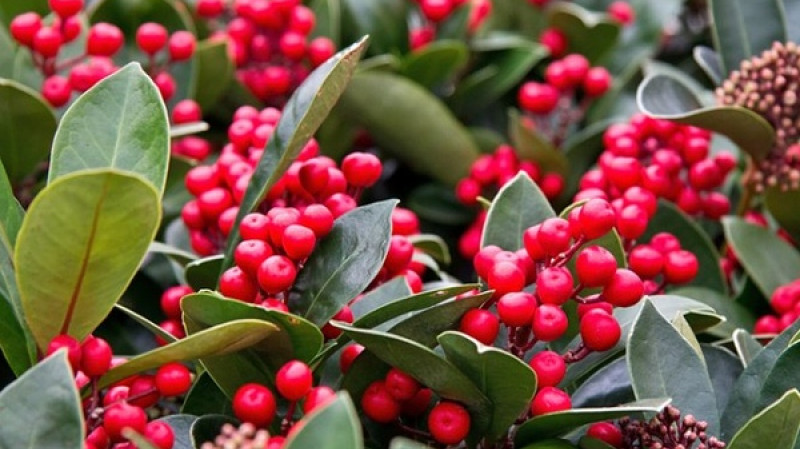You are here: Get winter colour to your garden
Gardens don’t have to be dull and drab in winter. With a little thought you can introduce colour and interest all year round

Image supplied by Hillier Nurseries
Winter Berries
Winter colour can easily be added to your garden with berries. Glossily evergreen, the English Holly (Ilex aqufolium) is a much-loved conical-shaped tree famous for its prickly leaves and bright red berries. Evergreen Cotoneaster shrubs carry clusters of brilliant red berries and provide useful ground cover. Wintergreen (Gaultheria procumbens) is low and creeping with bright red berries and dense evergreen foliage. It will form a nice carpet of dark green, red tinged foliage and can work well as an informal path edging.
In addition to the classic red berries or the vibrant purple ones of the deciduous shrub (Callicarpa bodinieri), the snowberry (Symphoricarpos albus) produces some of the purest white berries. Sea buckthorn (Hippophae rhamnoides ‘Leikora’) is another colourful shrub with deciduous silver leaves and orange berries throughout winter.
As well as providing a colourful display in the garden, foliage with winter berries is useful for indoor floral decorations. Plus, berries are a great source of food for birds.
Evergreen and deciduous shrubs
Evergreen foliage in all its hues adds life to winter beds. Hedges of evergreens, such as Cherry Laurel (Prunus laurocerasus Rotundifolia), are invaluable as they provide solid structure and privacy all year round. Laurels with large, glossy leaves can also work well as a small tree. Photinia Red Robin hedging (Photinia x fraseri) bears brilliant red young leaves which give a spectacular display in spring and summer before maturing to dark green in winter. Evergreen shrubs can be mixed with deciduous shrubs to bring variety to winter borders. Beech gives a distinctive effect in winter as the drying leaves remain on the branches and change colour from green to chestnut brown.
Winter-flowering shrubs and perennials
Winter-flowering plants are less plentiful than those that bloom in summer but can still provide beautiful colour and form often accompanied by amazing scent. Mahonia japonica is a large, evergreen shrub with arching sprays of pale primrose-yellow flowers and perfume like the lily of the valley. The first flowers appear in early winter. Several shrubby honeysuckles are winter bloomers. Species include Lonicera x purpusii ‘Winter Beauty’ bearing little, buttermilk yellow flowers. Other key shrubs include Contorta, a striking, corkscrew hazel which has fantastic twisted stems.
Vibernum tinus is a large, evergreen shrub with dark green leaves and eye-catching white flower clusters. It’s a popular choice for hedging. Be aware they are vigorous shrubs and need firm pruning in spring.
The Christmas rose (Helleborus niger), a semi-evergreen perennial, has an extraordinary flowering season. A late-bloomer, it starts to flower in November-December with pure white or pink-flushed white, bowl-shaped flowers up to 8cm in width.
Seedheads
Cutting back perennials during autumn ensures neat and tidy borders. However, it removes potential winter interest in the form of height and texture, plus food and habitat for wildlife. Selective cutting back can retain the fragile flowerheads which can be used in dried floral arrangements. Examples include hydrangeas, New Zealand flax (Phormium) and the architectural stems of ornamental grasses. The prickly seedheads of the thistle-like sea holly Eryngium variifolium provide striking silhouettes and are best left. The dried seedheads of honesty, Lunaria annua, hang like paper moons, adding a silvery sparkle to winter borders. Echiniacea and Rudbeckia with their pronounced central cone, look dark and bold after their petals fall.
Through the window
Views from the windows of your home provide a link to the garden all year round. In winter, after deciduous trees have shed their leaves, the bare bones of the garden are exposed. A back wall or fence can become more prominent. Why not plant a beautiful tree to add a new focal point? The silver birch (Betula pendula) with its gleaming white trunk can draw the eye into the garden and provide all-year round interest as can the bright winter stems of Japanese maple (Acer palmatum). Plant little winter bulbs - white snowdrops and canary-yellow aconites - close to the house where you can see them from a window.
Seasonal planters
A collection of pots of varying sizes grouped together by your front door on your patio or decking can provide winter colour. Pots of clipped Boxwood and Rubella (Skimmia japonica) with its shiny dark leaves made a good base. Then add in smaller pots of winter-flowering plants for splashes of colour. Cyclamen thrives in cooler temperature and is very versatile with its colour variations including pretty pinks, reds and white. Other winter-flowering plants sure to brighten up your pots include heather, pansies and violas.
Wintergreen works well when combined with other plants in seasonal planters. The thick glossy foliage and long-lasting berries form the perfect foil to the Christmas Rose that reveals its beautiful white blooms from November and can also be easily cultivated in pots.
While many plants retire for their winter rest, some shine. There are multiple ways to add winter colour whether it’s fantastic foliage, flowers, berries, stems or evergreen leaves. A well-planned winter garden will give you a whole new season to enjoy your outside space.
If you are thinking of improving your garden, you may find some of these services useful:
Garden Design
If you are looking for help in improving your garden
Arboricultural Surveys
To assess trees growing near to properties
Expert Witness Aboriculture
Find local Expert Witnesses to help with tree Issues
Invasive weeds report
If you are concerned that you may have invasive weeds.
Ecological Surveys
A survey of the environment for wildlife that may affect any building or development